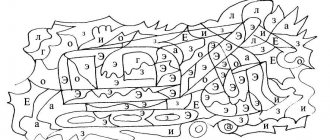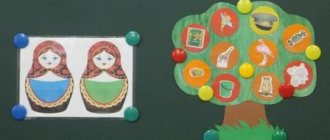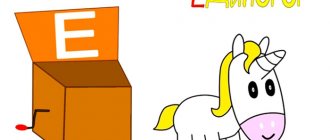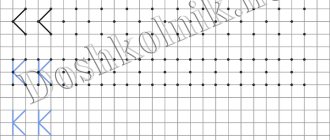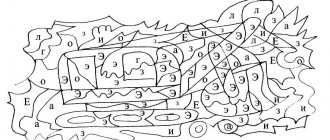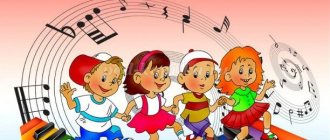Everything has its time
Mastering literacy is the result of the development of all aspects of a child’s personality at the border between preschool and school age, stated the famous scientist, author of the peer education program E.E. Shuleshko. This is confirmed by other researchers.
Varentsova N.S. notes that from the age of 4 years a restructuring of the child’s attitude towards speech occurs, and it is necessary to pay attention to sound analysis from this age. Children after 4 years of age are very interested in language in terms of the relationship between sound and content, but after 5 years of age this interest wanes. And if a child under 6 years of age has not developed the skill of identifying sounds in a word, in the future it will be more difficult for him to master reading. This means you can’t start reading without mastering phonetic analysis: identifying the first and last sound in a word, determining the number of words, determining the number of vowels and consonants, etc.
From the age of 5 you can start learning the basics of grammar (the alphabet, highlighting syllables, etc.). L.A. Wenger and S.V. Mukhina indicate that children at this age are most receptive to learning to read and write, since they are distinguished by the sharpness and freshness of perception, curiosity and vividness of imagination. However, the memory and attention of children at this age are very unstable, so it is necessary to return to what is already familiar many times in order for the knowledge to become strong.
From the age of 6, children show a special interest in reading and are especially successful at this stage of learning. Therefore, it is advisable to give all the necessary knowledge in the field of sound reality and grammatical analysis to children at an earlier age.
Mastering literacy is the result of the development of all aspects of a child’s personality at the border between preschool and school age. And if children’s interest in reading and writing is satisfied in a timely manner, mastering the school curriculum occurs normally.
From the nursery to the desk?
A logical question arises: how to teach literacy to young children so that it is interesting and not difficult for them?
Of course, there is no need to put them at desks in kindergarten; it is important to do this in preschool ways: come up with tasks related to what interests them, include literacy training in different types of work with children. For example, everyone should create name tables with names and dates of birth together, allow children to write down the rules of the group themselves, come up with calendars, sign their works, etc.
It is important that during classes the child can observe, explore, make connections, identify dependencies, generalize, compare, draw conclusions, actively play and manipulate the material and discuss what he is doing with his peers.
Learning to read and write in general can be based on all types of activities available to the child: singing, playing music, physical education, design, dramatization.
In these activities, children will also develop motor coordination, rhythmic, tempo, melodic, spatial, muscular and language skills. Where to get ideas Not many works are devoted to the practical side of teaching literacy to preschoolers, but there are textbook works and thematic resources where you can find many effective exercises and ideas: ✔ “Understanding Literacy” by Evgeniy Shulezhko is a fundamental scientific and pedagogical work, in which, in addition to theories, the author's methods of teaching writing, reading and mathematics are presented; ✔ “Always Together: A Methodological Guide for Parents of Children with Hearing Pathology” by Emilia Leongard - despite the fact that the book is focused on working with hearing-impaired children, you can find many useful exercises and approaches to how to arouse interest in speech;
Internet resources: ✔ The Open Lesson website contains a lot of information on teaching literacy to preschoolers. The above-mentioned books can also be found there; ✔ The “School for All” project is a useful online resource dedicated to working with schoolchildren and preschoolers. Affiliate material Subscribe to the channel University of Childhood
If everything is left to chance
If literacy is not given due attention in early childhood, then some children may experience a number of problems when entering school.
Thus, children aged 6-7 years often have difficulties with tasks that require the correlation of symbolic and real planes, with the analysis of symbolic means in form (graphics, gestures, sounds) and in the nature of the connection with the designated object (similarity or conditional connection), with the designation of some and the same objects in different ways.
This occurs because the level of generalization and abstraction of individual concepts may not entirely correspond to their level of development. Understanding the structure of the alphabet and the structure of mathematical expressions (2a = b, for example) is built precisely on abstract symbolic representations.
It is important that by the beginning of school the child has an idea of the alphabet - about vowels and consonants, about the structure of a syllable, about the natural series of numbers. Understanding these patterns creates a sense of cultural inclusion in the child.
In general, many mistakes that children make at school are the result of oversight by preschool workers. It is believed that if a child is simply healthy and emotionally preserved, this is enough for his education to continue to be successful. And if someone at school, for example, has problems with the Russian language, then they are often attributed to psychological development and are classified as speech therapy.
But to avoid such difficulties, you should simply start mastering complex sign systems earlier.
A little theory: sign and sign systems
Literacy is one of the sign (semiotic) systems that provide a uniform representation and interpretation of the signals and messages that people exchange in the process of transmitting information.
The formation and use of semiotic systems is a natural way for humans to structure experience, socialize and transfer knowledge from generation to generation. In fact, our entire existence is permeated with sign systems: phonetics, language, counting, ritual, art, etc. Social relations as a whole can also be considered as a sign system.
The unit and basis of any semiotic system is a sign - an abstract or material object, in relation to which it is accepted that it indicates a certain meaning. A sign has a plane of content—meaning—and a plane of expression—these are linguistic or material means by which the meaning is conveyed.
In cultural studies, the dual essence of the sign is well explained by the concept “Bonfire of Hell”. It is based on the Greek legend of how the young man Leander swam across the Bosphorus every night to meet his beloved. The sign of invitation to the beginning of his journey was the fire that the girl lit in her tower. Here the fire is the material expression of the sign. An invitation to a meeting – its meaning, content.
We can distinguish signs of personal use (for example, the fire from the above-mentioned legend) - they are understandable only to a few people, significant only in the context of their relationships - and signs of general and professional use (counting, language, ritual), with the help of which objects of nature and technology are included in culture. But in both cases, the creation of signs is a social activity that expresses the uniqueness of life, feelings, and mental activity of other people.
With the help of signs, we not only socialize, but also cognize reality: by constructing semiotic systems, we endow material and abstract objects with conventional meaning and establish connections between them. When these systems acquire a historical and social dimension (everyone distinguishes and interprets signs in the same way), they consolidate experience and serve to transmit it from generation to generation.
The transfer and assimilation of experience is facilitated by an important property of semiotic systems: the design of signs explains their content even if there is no special condition for understanding the meaning of an individual sign. A striking example of this is the phrase coined by Academician Shcherba: “The glokaya kuzdra shteko budlanula bokra and kurdyat bokrenok.” Despite the fact that we do not know the meaning of the words in this sentence, based on morphological features and their relationship to each other (which are given by the grammar system), we can understand the general meaning of the entire phrase: some feminine entity did something to another male entity , and then began (and still continues) to do something different with a smaller representative of the same species. This principle, for example, is indispensable in deciphering ancient writing.
It turns out that by understanding what a sign is, how it relates to reality (the plane of expression and the plane of content), and how at least one sign system is organized, it becomes easier to work with the others in the future. For example, learning the grammar of a foreign language can help you understand how programming languages function.
And if in order to theoretically study what signs and sign systems are (this is the science of semiotics) it takes considerable time and developed intelligence, then children begin to intuitively comprehend the practical side of the issue from an early age. And the task of preschool education is to help them with this in a timely manner.
Including children in significant activities
The child’s sign activity, in fact, begins with a gesture, an indication of the desired object or a call to action. According to Vygotsky, gesture gives rise to speech, drawing and play - symbolic activities of the first order, which directly reflect reality. It is during the process of play that the object and its function are separated: different toys receive different purposes (an airplane - to fly, a car - to drive). With the help of names, the child establishes connections between a sign (name) and a specific object: he says “car” and picks up a car, not a plane. Speech, play and drawing give rise to written speech, symbolic activity of the second order (it no longer reflects immediate reality, but drawing or play). All these external symbolic forms of activity are included in the system of higher mental functions, which are formed in the process of social communication.
Therefore, a prerequisite for mastering sign-symbolic reality is the child’s interaction with adults and peers: the pointing gesture - the beginning of all principles - arises precisely from addressing another. If there is no one to show it to, then there is no point in it. The same goes for more complex activities: reading is always addressed to an imaginary interlocutor, writing is always addressed to an imaginary addressee. Only in this way do they arise as cultural functions. Otherwise, at the beginning of mastering literacy, the child does not understand why he himself needs it.
Thus, from an early age, mastering sign activities, the child feels quite comfortable, being under the guidance of an adult and surrounded by peers. The question remains: when is it appropriate to move from mastering one sign system to another, for example, from phonetics to grammar? Representatives of the Russian school of psychology have interesting answers to this question.
Senior group. Senior preschool age. Children 5-6 years old
Homework for parents in the senior speech therapy group “I am a Human.” Sound [R]" Topic: I am a Person Parents are recommended to: • Tell the child about a person, parts of the body and the actions that a person can perform with the help of these parts. 1. Articulation gymnastics for the sound P (see Appendix 2)
! For parents, I print out applications in advance for folders with remote sensing...
Summary of a logorhythmic lesson in a senior group with children with a speech disorder “Journey to the land of sounds and letters” Logorhythmic lesson in a senior group with children with a speech disorder. Journey to the land of sounds and letters . Integration of educational areas: “Speech development”
,
“Social and communicative development”
,
“Cognitive development”
,
“Artistic and aesthetic development”
,
“Physical development”
...
